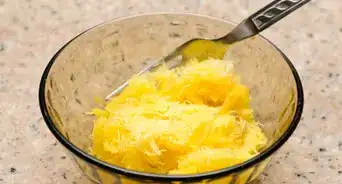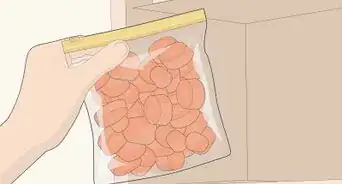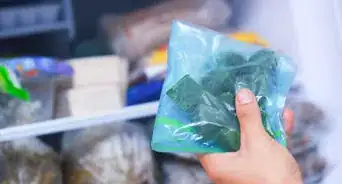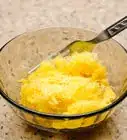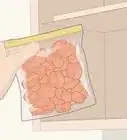This article was co-authored by Linda McNally. Linda Ingaldson McNally is a Personal Chef & Nutritionist and the Co-Founder of Sage Home Chef based in Portland, Oregon. Linda and her team specialize in personalized meal preparation and create seasonal menus to accommodate various dietary restrictions. She has extensive knowledge in nutrition relating to women's health, mindful eating, and therapeutic diets. Sage Home Chef won the AI Business Excellence Awards for Oregon's Best Healthy Cuisine Personal Chef Services and Best of Portland Personal Chef Services in 2022. Linda has a degree in Journalism, Social Justice, and Family Studies from the University of St. Thomas and earned an MS in Nutrition from the National University of Natural Medicine in Portland.
There are 10 references cited in this article, which can be found at the bottom of the page.
wikiHow marks an article as reader-approved once it receives enough positive feedback. This article received 14 testimonials and 87% of readers who voted found it helpful, earning it our reader-approved status.
This article has been viewed 407,442 times.
Butternut squash is delicious and healthy, and you can use it in a number of different recipes. Buy butternut squash when it’s in season and freeze it so you can enjoy it year-round!
Steps
Freezing Raw
-
1Prepare the squash. Peel and cut the squash into your desired size.[1]
- Cut the squash in half and cut off both ends. The squash should be able to stand flat on its end.
- Use a sharp chef's knife with a smooth blade to shave off the outer peel.[2]
- Cut the butternut squash into cubes. For most purposes, 1-inch (2.5-cm) cubes work best, but you can make the cubes larger or smaller as desired.
- Remove the seeds and pulp as you cube the squash.
-
2Spread the chunks out onto a baking sheet and freeze.[3] Line the baking sheet with parchment paper and place the butternut squash pieces on top. Freeze the pieces for several hours or until completely frozen solid.
- Make sure that the pieces are spread out in a single layer and are not touching each other. The pieces of raw butternut squash should be frozen separately, but if they are stacked or touching, they will freeze together instead.
- If you do not have parchment paper, wax paper will also work well.
Advertisement -
3Transfer to a freezer-safe container. After the pieces have frozen completely, place them in a large freezer-safe plastic container.
- Leave 1/2-inch (1.25-cm) empty headspace at the top of the container. As food freezes, it expands. The extra space allows the squash extra room to expand.[4]
- Avoid using glass containers since glass is more likely to shatter in the freezer.
- If desired, you could also use resealable plastic bags as long as they are freezer safe.
- Mark the container with the current date so you will know, for future reference, how long the butternut squash has been in the freezer.
-
4Freeze. Place the containers of frozen butternut squash in the freezer and store for 6 to 12 months, or until the squash shows signs of decay or freezer burn.
- Frozen chunks of butternut squash can usually be used directly from the freezer, but you may also thaw them to reduce cooking time.
Freezing Cooked
-
1Preheat the oven to 400 degrees Fahrenheit (204 degrees Celsius). Locate a baking dish with deep sides that is at least twice as wide as the squash.
- If you do not have any baking dishes that are large enough to fit two halves, you may need to use two separate dishes.
-
2Cut the squash in half lengthwise. Use a sharp chef's knife to cut the butternut squash in half from top to bottom.
- Remove the seeds and stringy pulp with a metal spoon, melon-baller, or metal ice cream scoop.
-
3Place the halves in the baking dish and add water. Position the halves so that they are flat inside the dish with the cut-side facing down. Add roughly 1/2 inch (1.25-cm) of water to the dish.
-
4Bake for 45 to 60 minutes. Cook the squash until it just begins to soften.
- Remove from the oven and let cool, 30 to 60 minutes, or until it has cooled enough for you to touch the squash without burning your fingers.
-
5Peel and dice the cooked squash. Peel the skin away with your fingers and use a knife to dice the squash into 1-inch (2.5-cm) cubes.
- If you are having a hard time peeling the skin off by hand, you can shave it off with the knife.
-
6Freeze the cubes on baking sheets. Place the cooked cubes on a baking sheet lined with wax paper or parchment paper. Freeze for 1 or 2 hours or until the chunks are frozen solid.[5]
- The cubes must be arranged in a single layer and should not be touching one another. Otherwise, the pieces of butternut squash may end up freezing together, making them more difficult to use.
-
7Transfer the cubes to freezer-safe containers. Once the cubes are frozen solid, place them inside resealable plastic freezer bags.[6]
- You could also use freezer-safe plastic containers, but glass containers are not recommended since glass is more likely to break when frozen. Leave 1/2-inch (1.25-cm) empty headspace at the top of the container to allow the butternut squash cubes room to expand.[7]
- Label the bag or container with the current date so you will know how long the squash has been in your freezer later on.
-
8Freeze until ready to use. Butternut squash can be saved for 6 to 12 months when frozen.[8]
- Pre-cooked squash cubes are often easier to use straight from the freezer, without thawing them first, than raw squash cubes are.
- You can cook the squash in boiling water for 4-5 minutes or until it becomes tender. Then drain as much excess moisture from the squash pieces as possible.
- Put them in airtight containers.
- Date the containers or bags and keep them in the freezer.
Freezing as Puree
-
1Slice the squash in half. Use a sharp chef's knife to divide the butternut squash in half, cutting lengthwise from top to bottom.
- Depending on the size of your cooking dish, you may need to cut the squash in half once more so that it will fit. Cutting the squash into quarters may also make it easier to remove the seeds.
- Scoop out the seeds and pulp. Use a metal spoon, melon-baller, or metal ice cream scooper to dig out the seeds and stringy pulp.
-
2Place the squash in a microwave-safe dish and add water. Arrange the squash pieces in a microwave-safe glass dish with the cut-side facing down. Add roughly 2 inches (5 cm) of water to the dish and cover.
- If you do not have a big enough dish to fit the entire squash, you may need to cook it in batches. Alternatively, you can cook the squash on the stove in a stockpot filled with boiling water for approximately twice as long.
-
3Microwave the squash on High for 15 minutes or more. After 15 minutes, poke the squash with a fork. If it feels soft enough to scoop out, the squash is done.
- If the squash is not soft enough, continue microwaving it for 3 to 5 minutes at a time until done. This process usually takes about 20 to 30 minutes total.[9]
-
4Scoop out the cooked flesh. Use a large metal spoon to gently scoop out the cooked squash from its skin.[10]
- If cooked enough, the squash should come out of its skin with relative ease.
- Let the squash cool slightly before you handle it to minimize the risk of burns. You may also want to hold the squash with an oven mitt or dish towel as you work.
-
5Puree the squash. Place the squash in a bowl or container and use an electric hand blender to mash the squash until it develops a smooth consistency.
- You could also use a standard blender, hand mixer, or fork to puree the squash, but a hand blender is the most convenient and quickest tool to use.
-
6Pack the squash in containers and freeze. Transfer the butternut squash puree to a freezer-safe plastic food container. Freeze up to 12 months.[11]
- Leave roughly 1/2-inch (1.25-cm) of empty headspace so that the squash has room to expand as it freezes.[12]
- This method is especially useful if you already know that you will need to use the squash in puree form.
- You could also use resealable plastic freezer bags instead of the plastic container. Ice cube trays with covers or ice cube trays covered in plastic wrap will also work well.
- Label the container or bag with the current date before placing it in the freezer.
-
7Finished.
Community Q&A
-
QuestionWhat should I do if I froze the butternut squash without separating the chunks?
 Community AnswerSet the bowl in warm water just long enough to pull what you need off without allowing the squash to thaw completely.
Community AnswerSet the bowl in warm water just long enough to pull what you need off without allowing the squash to thaw completely. -
QuestionCan I freeze butternut squash puree in a mason jar using the food-saver attachment? I know you can't can, and am looking an alternative.
 Community AnswerYes, I do that all the time. It is easy and fun. I mix a little (half a teaspoon per pint) Miracle Whip in when freezing, which helps the freezing process, locks in the flavor, and helps prevent freezer burn.
Community AnswerYes, I do that all the time. It is easy and fun. I mix a little (half a teaspoon per pint) Miracle Whip in when freezing, which helps the freezing process, locks in the flavor, and helps prevent freezer burn. -
QuestionCan I vacuum seal after the chunks have frozen?
 Zachary William JoubertCommunity AnswerIf you absolutely must, you can. However, you wont get as much of the air out of the package as if it were thawed. It should be used fairly soon.
Zachary William JoubertCommunity AnswerIf you absolutely must, you can. However, you wont get as much of the air out of the package as if it were thawed. It should be used fairly soon.
Things You'll Need
- Chef's knife
- Metal spoon, melon-baller, or ice cream scoop
- Baking sheet
- Parchment paper or wax paper
- Freezer-safe container or bag
- Baking dish
- Oven mitts or dish towel
- Permanent marker
- Microwave-safe dish
- Hand blender, blender, or hand mixer
References
- ↑ https://www.thekitchn.com/how-to-cut-and-peel-a-butternut-squash-249946
- ↑ http://www.thekitchn.com/how-to-peel-squash-an-easier-w-72035
- ↑ http://www.thekitchn.com/two-ways-to-freeze-winter-squash-178166
- ↑ https://nchfp.uga.edu/how/freeze/squash_winter.html
- ↑ https://spoonuniversity.com/how-to/how-to-freeze-butternut-squash
- ↑ https://spoonuniversity.com/how-to/how-to-freeze-butternut-squash
- ↑ https://nchfp.uga.edu/how/freeze/squash_winter.html
- ↑ https://extension.umn.edu/preserving-and-preparing/preserving-winter-squash-and-pumpkins
- ↑ http://pickyourown.org/freezing_wintersquash.htm
About This Article
To freeze butternut squash raw, first peel the squash and cut it into cubes. Remove the seeds and pulp as you cube the squash. Line a baking sheet with parchment paper and spread out the butternut squash in a single layer so the pieces aren’t touching each other. Freeze the squash for several hours, then transfer to a sealed container and return to the freezer. For tips on how to freeze cooked or pureed squash, keep reading.
